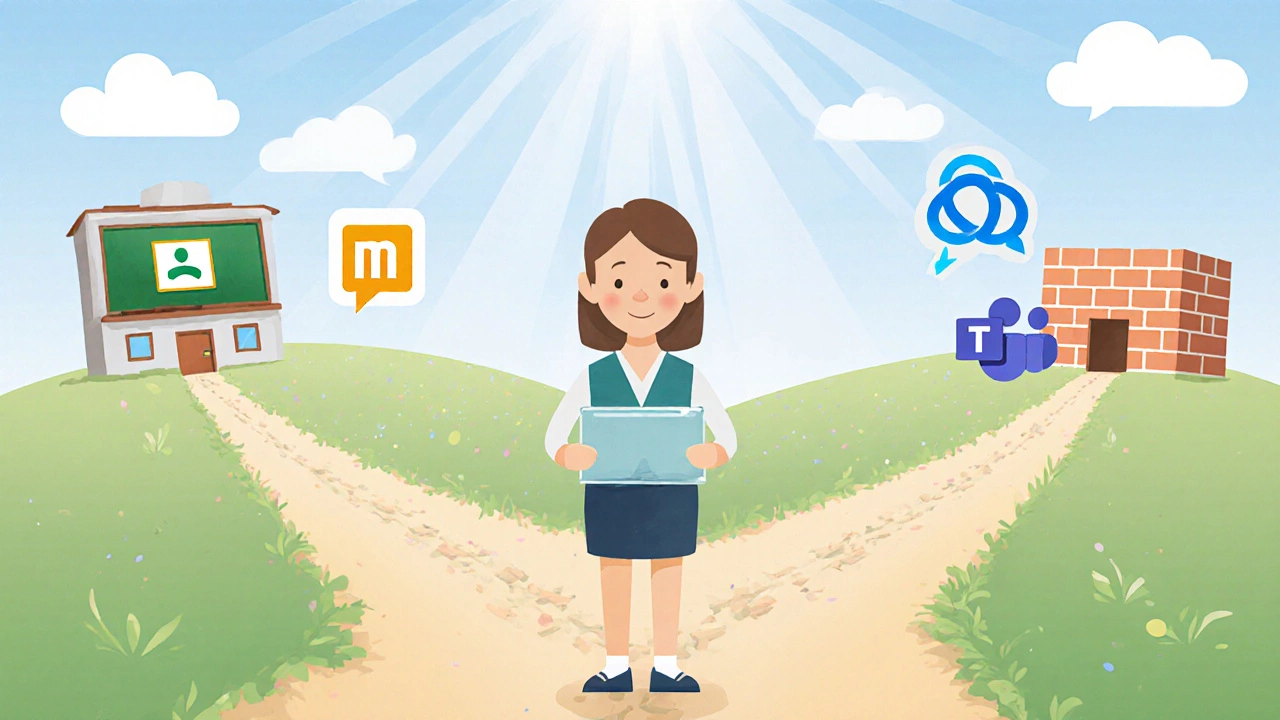Google Classroom Cost Calculator
Calculate Your School's Costs
Estimate annual expenses for Google Workspace for Education based on your student count and feature needs
Cost Estimate
Key Features Comparison
Free Tier
- Unlimited classes and students
- Basic assignment management
- Google Drive integration
- Basic communication tools
Standard Tier
- Everything in Free Tier
- Custom email domains
- 100GB storage per user
- Enhanced security
Plus Tier
- Everything in Standard Tier
- Enterprise-grade security
- Advanced analytics
- Priority support
What you need to know up front
Many teachers wonder if they can run a digital class without paying a dime. The short answer is yes - Google Classroom free gives you a solid, no‑cost LMS that works for most K‑12 and higher‑education needs. But the story doesn’t end there. Google also offers paid upgrades, and a handful of rival platforms provide extra bells and whistles that some schools find worth the expense.
Google Classroom - the free foundation
When it comes to digital classrooms, Google Classroom is a web‑based learning management system that lets teachers create, distribute, and grade assignments while keeping students in the loop through a simple interface. The free tier includes:
- Unlimited classes and students per class.
- Assignment creation, due‑date tracking, and automated grading for quizzes.
- Integration with Google Drive, Docs, Slides, and Sheets for seamless file sharing.
- Basic communication tools - announcements, comments, and private chats.
- Student‑friendly mobile apps for Android and iOS.
All of this runs on Google’s cloud, so schools don’t need to worry about server maintenance or licensing paperwork.
When the free plan isn’t enough - paid upgrades
For institutions that need tighter admin control, advanced security, or deeper analytics, Google bundles Classroom into Google Workspace for Education. This suite comes in three flavors:
- Fundamentals - still free, adds basic admin console and compliance tools.
- Standard - paid, provides custom email domains, enhanced security, and larger storage quotas (up to 100 GB per user).
- Plus - premium, adds enterprise‑grade security, advanced analytics, and priority support.
Pricing varies by country and enrollment size, but most Indian schools pay roughly ₹1,200 per user per year for the Standard tier. The Plus tier can climb to ₹3,500 per user per year.
How the free version stacks up against paid features
| Feature | Free Classroom | Workspace Standard | Workspace Plus |
|---|---|---|---|
| Custom domain email | No | Yes | Yes |
| Advanced admin console | Limited | Full control | Full control + audit logs |
| Storage per user | 15 GB (shared) | 100 GB | Unlimited |
| Security & compliance | Basic SSL | 2‑step verification, SSO | Enterprise‑grade DLP, S/MIME |
| Analytics & reporting | Basic usage stats | Classroom insights | Advanced usage dashboards |
If your school only needs core classroom features, the free version covers most daily tasks. Upgrade only when you need the admin and security layers that larger districts demand.
Key Google ecosystem tools that complement Classroom
The power of Google Classroom comes from its tight integration with other Google services:
- Google Meet - video‑conferencing built directly into assignments and announcements.
- Google Docs - real‑time collaborative documents for essays, lab reports, and peer reviews.
- Google Forms - quick quizzes or feedback surveys that auto‑grade and feed results back into Classroom.
- Chrome OS - low‑cost laptops that run the suite flawlessly in labs.
Because everything lives under the same Google account, teachers spend less time juggling logins and more time teaching.
Free alternatives - when you might look elsewhere
If you need features the free tier lacks - such as built‑in plagiarism detection or extensive LMS reporting - consider these platforms:
- Moodle - an open‑source LMS that’s highly customizable, but requires hosting and technical upkeep.
- Microsoft Teams for Education - combines chat, video, and assignment tools; free for schools but tied to Microsoft 365.
- Edmodo - a social‑style classroom hub; free tier limited to basic posts and quizzes.
Each alternative has a learning curve. If your school already uses Google Workspace for email, sticking with Classroom usually saves the most time.
Step‑by‑step: Setting up a free Google Classroom account
- Sign in to your Google account (or create one at accounts.google.com).
- Navigate to classroom.google.com and click “Create class”.
- Choose “Teacher” and fill in the class name, section, subject, and room number.
- Invite students by sharing the class code or sending email invitations directly from the “People” tab.
- Start posting announcements, creating assignments, and attaching files stored in Google Drive.
All these steps are free, and you can add co‑teachers whenever you need a backup.

Tips to get the most out of the free tier
- Use Google Forms quizzes to automate grading for multiple‑choice tests.
- Leverage the “Reuse post” feature to copy assignments across semesters.
- Set up “Stream” notifications so students get real‑time updates on due dates.
- Organize files in Drive folders named after each class to keep resources tidy.
- Encourage students to use the mobile app for offline access; the app caches assignments for later review.
Common concerns and quick answers
Below are the questions teachers and administrators often ask when they first explore Google Classroom.
Is there any hidden cost for using Google Classroom?
No. The core Classroom service is completely free for anyone with a Google account. Costs only appear if you opt into Google Workspace for Education paid tiers.
Can I use Classroom with a non‑Google email address?
Yes. Teachers can sign up with any email that supports Google accounts (Gmail, Outlook, etc.). Students, however, need a Google‑linked account to join.
Is student data private?
Google complies with FERPA and GDPR for education users. The free tier still encrypts data in transit and at rest, but larger districts often upgrade for added audit controls.
Can I integrate third‑party apps?
Yes. Classroom supports LTI (Learning Tools Interoperability), allowing tools like Quizizz, Kahoot, and Nearpod to launch directly from assignments.
What happens if I switch to a paid Google Workspace tier later?
All existing classes, assignments, and student data migrate automatically. You simply get more admin features and storage.
Bottom line - is Google Classroom free enough?
If your school’s main goal is to deliver assignments, collect work, and hold virtual meetings without extra cost, the free version does the job. Upgrade only when tighter admin control, larger storage, or enterprise‑grade security become non‑negotiable. And if you ever outgrow it, robust alternatives like Moodle or Microsoft Teams are ready to fill the gaps.
